QuestionQUESTION: I have really enjoyed your forum here, it has answered some of my questions about raising our new bundle of energy properly, but it has raised some new questions. Diamond was a rescued dog and eats as if she was never going to get another meal. She swallows the food whole, no chewing. If I fed her what she would eat in 10 to 15 minutes like you suggest she would eat a weeks worth of food, we tried just upping her meal allowance a bit to see if it would slow her down and all that happened was that she gained weight. Any other ideas? We have been working on this for about 5 weeks. We walk her with a harness and leash. We let her off leash quite often and she always comes when called. Teaching her to stay and not jump on people is another story. She seems to really have a lot of husky traits and looks purebred although we are quite sure she is not. I don't want to stop letting her off leash when she is happy and obedient. Your comments about this subject make me wonder. I would like some training tips about the jumping and staying.
ANSWER: Glad you've found this helpful. And as you can see, every dog is a little different, so you have to take much of the advice with the ideas behind it. First, Diamond's eating habits. You don't mention how old she is, but here's my advice:
1) Find a high quality kibble (main ingredients being meat based)
2) A dog will need increasing amounts of kibble until around 6 months of age (give or take a few months) and will taper off to an adult amount somewhere around 12-18 months of age.
3) The recommended amounts on the bag are usually overkill.
4) Your dog should maintain an overall weight gain through puppy stages, and then after you should be looking at maintaining weight of course.
5) Keep an eye on stools - loose or runny stools can be a sign of overeating (or under-eating actually!).
If Diamond is a voracious eater, try splitting her meals up more so she eats more often, but the same amount. If she is an adult dog that normally eats 2 cups of food per day, you may want to try giving her 3 or even four meals at 1/2 - 3/4 cup per feeding. She might eat it all down in 3 minutes, but you might notice that she eventually slows down to because she is used to eating on a regular basis.
If she is gaining weight, I'm not too worried about parasites, so it sounds like she just might not be used to frequent meals. No big deal, just work with her.
As for off-leash, I definitely recommend against it, but I do know a lot of Husky mixes that have done fine with it, and heck, I've even known a few purebred Sibes that do alright too. The main reasons I'm against it:
1) Sibes don't have a natural homing instinct. They were bred to be nomadic dogs and often get lost easily.
2) Sibes were bred to run, and running 20-30 miles for a fun jog from the house isn't uncommon. Which means they probably aren't just hanging out with your neighbor at the end of the street.
3) Sibes have extremely high prey drives. What this means on a lot of levels is that they will chase things they want and ignore everything else. What they ignore most often? Recall commands and oncoming cars.
I have heard stories of Sibes being great for years off-lead, and then one day, running off. One story was of a dog running across a street after a squirrel and getting hit, the other was a dog playing around in the woods with the owner while hiking. Dog saw a rabbit, ran over the next hill and the owner thought, "No big deal, I'll see her in a few feet as soon as I get over the hill." The dog was lost for over 6 months before being returned by the Humane Society because she was fortunately chipped. (The dog had been living in the woods and ended up hanging out at a construction site about 15 miles away for weeks up until her rescue.) For me, I'd just rather not risk it. However, if I had a mix, I'd be more likely to give in to the off-lead work.
As for jumping up and staying, I'll start with staying. It's actually really difficult to get a dog to stay, but here's the method I've used for everything.
First, teach the dog the command. In this case, if you are teaching a down-stay (easier than a sit-stay), you give the "Down" command (which the dog should have reliably before working on "Stay") and then command "Stay". At that point, you hold the dog physically in the down position. Continue to physically keep the dog in the "down" position until you release it. (I used "Free!" as a command.) Do this for a week or so and what you are doing is teaching the dog to relate "Stay" to not moving, and "Free!" to be that she is released from the stay. You'll want to release the dog before she gets to squirmy, but you should notice the time it takes for her to start trying to get up go from maybe just a second or two to eventually at the end of the week her just laying there for a minute or so, impatiently waiting for you to let her go.
Once you teach the command (which may take a week or a little more), you want to activate free will. At this point, you command "Down" and then "Stay" and don't hold the dog. Inevitably, the dog will get up, and at that point, you correct the dog. Corrections really depend on the dog. My male could easily be correct by a stern "NO!" and maybe a little push on the neck. My female didn't respond as well to the verbal correction, and usually required a quick downward leash "pop" to remind her to lay down.
It's the easiest method to teach almost any basic obedience. Don't give the dog a choice for a while, and then, once the dog gets used to the command equaling something, you let them have a little freedom to try to do it on their own. (For example, I taught "Heel" by giving the command and then walking the dog on a basically 12-inch leash right by my leg.)
With Sibes being such stubborn and high-drive dogs, I generally stay away from treat-based training for true obedience. I use treats more for positive crate experiences, or just fun tricks. Basic obedience (loose-lead walking, heel, sit, down, and stay) all were down with this method of physically guiding and conditioning the dogs.
As for jumping up, there are a few things. One, realize why your dog is jumping. Sibes are very friendly and social dogs, and dogs socialize and greet each other by touching noses, sniffing mouths, etc. (and yes, the sniffing eventually moves to the other end, but I digress!). Anyway, when you get home, your dog will often want to jump up to greet you and re-socialize. With that being said, I decided that I didn't want to deny that to my dogs. I say hi to them with a voice and a pet, they want to say hi to me by sniffing my face (and usually giving a few kisses).
Therefore, by understanding their desire there, I decided to reshape the behavior into something more acceptable while still allowing them to do what they want. I usually greeted my dogs with either bending down to their level (no need to jump up to my face if it's right there), or, extending my bent arm out (like a waiter carrying a towel) to act as a ledge for my dogs. This allowed them to jump up, hold on the my arm, and greet me. Some consistency in doing this and both dogs now anxiously wait for my arm to come out or me to kneel down to them. They know I'll do it, and it makes their job easier.
If you wish to completely eliminate it, you'll have more work to do. However, the easiest method there is to simply ignore them until they are in a sit, or just standing. When they jump, you turn away and don't even look at them. Eventually, they'll get the idea. Also, through consistency and good obedience training, you can walk in and tell your dog "Sit!" and ignore her until she does. After a few days or weeks of doing that, you should notice that your dog comes running up and sits to greet you. Consistency is key here though. Don't make her sit one time before saying hi, and she'll think she doesn't have to. Also, you'll want to make sure other visitors do the same (ignore her until she sits). You choice on which way, but that should give you a starting point.
Hopes this long email helps some, but feel free to write back if I skipped anything or you need further clarification on a few points.
---------- FOLLOW-UP ----------
QUESTION: Diamond as I stated in the intro is approximately 4 months old, we are not exactly sure of how old the pups were when rescued. Thanks for the advice. Her eating habits have not changed we are not talking minutes, we are talking seconds, no chewing. She poops quite a bit for a little dog. Usually 3 large formed but looser looking stools per day. Regular meals just meant for her to chew on the food bin more often. She is growing, when we got her she was 14lbs, 13-14 inches, she is now 22lbs and about 15.5in. I will try the working on the stay command right away it is very important for her to learn. I wish I would have known about the high prey drives, I have two very unhappy cats. Will she settle with them? Shari
AnswerSorry about missing the age in the Subject heading, but yeah, she should continue to eat quite a bit, in increasing amounts for about two to three more months, and then it should begin to taper off. I would recommend three-four feedings per day. Also, you may wish to supplement her diet with some high protein food (meat of some sort). Sometimes that will help stick with their stomachs a little longer. Sounds like she is growing well though, so I wouldn't be too concerned. Keep an eye out for food aggression, as this is sometimes a problem with dogs who have such an appetite.
As for the cats . . . well . . . maybe. Siberians and cats are notorious for not being good companions. There are plenty of exceptions out there, but there are plenty of cases where the rule proves true. Basically, if the dog is raised with the cats, you have a CHANCE of the dog accepting the cats as pack members and not food. The problem is, there is no foolproof way of assuring this happens. There are plenty of stories of dogs who were raised with cats and seemed to alright, and then one day attack the cat. In most cases, I would guess it actually is "play" that goes too far. (Sibes are very playful and rough, and cats are a little more fragile than another 50 lbs. dog.) So, I definitely recommend separation and supervision of all interactions. I do know a few Sibes who are completely aloof to the cats, and that's the best you can hope for in most cases.

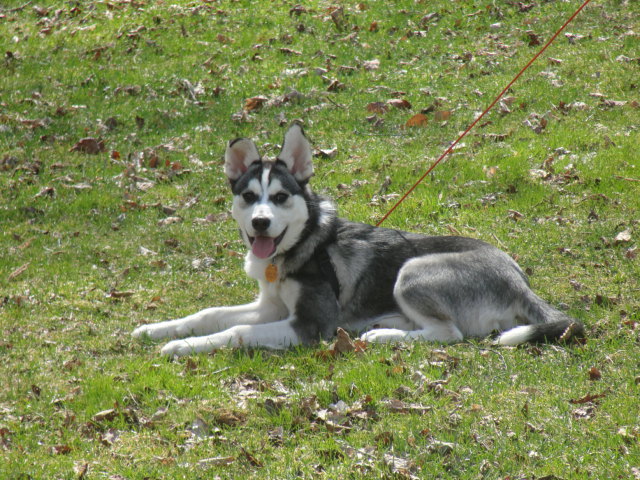 My 4 mo. old puppy
Question
Arkkan 4mo.old
I recently brought home my Sibe
My 4 mo. old puppy
Question
Arkkan 4mo.old
I recently brought home my Sibe
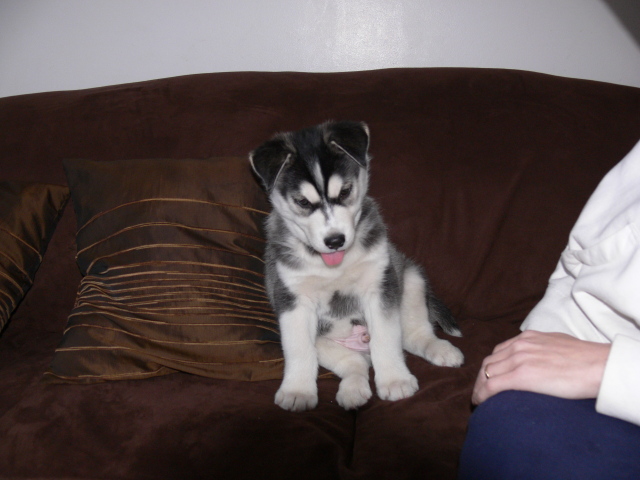 Husky Puppy Weight
Question
Zeus The Puppy
Hi we got Zeus at 6 1/2 weeks o
Husky Puppy Weight
Question
Zeus The Puppy
Hi we got Zeus at 6 1/2 weeks o
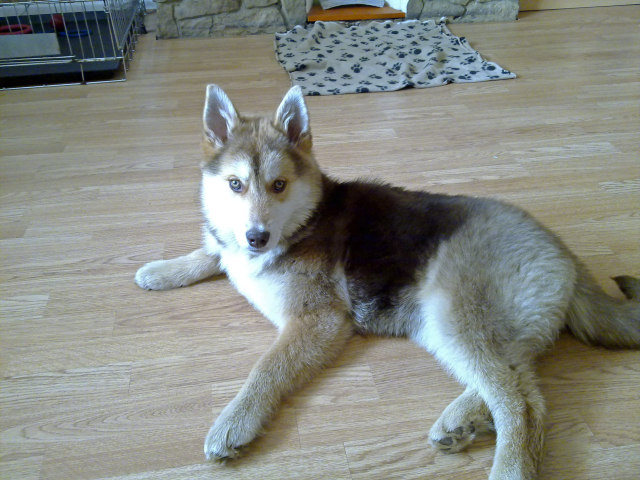 my husky colour
Question
mecca
hi i have recently got my husky mecca. s
my husky colour
Question
mecca
hi i have recently got my husky mecca. s
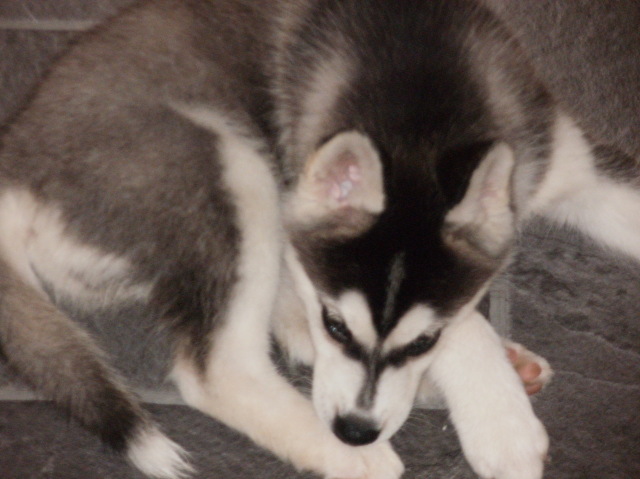 Bath Time
Question
Keiko
Hi we have a 14 week old Siberian named
Bath Time
Question
Keiko
Hi we have a 14 week old Siberian named
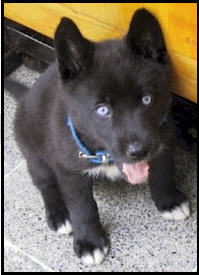 Crate Training a 7wk old Husky mix pup
QuestionHusky look-alike from
QUESTION: Weve re
Crate Training a 7wk old Husky mix pup
QuestionHusky look-alike from
QUESTION: Weve re